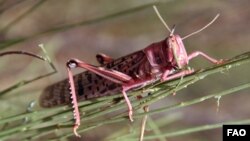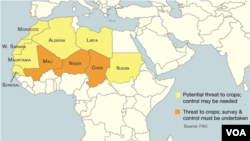Four countries in West Africa have been put on alert for the likely arrival of swarms of Desert Locusts. If uncontrolled, a small swarm can eat the same amount of food in one day as 35-thousand people.
Locust swarms are currently forming in Chad, northern Mali and northern Niger. But expert Keith Cressman said they’re not expected to stay there very long.
“As we’re at the end of the rainy season, the vegetation is drying out, conditions are becoming unfavorable for Desert Locusts, the swarms will then move. And they will move in a northerly direction, and we’re expecting them to move towards Libya, Algeria, parts of southern Morocco and northwestern Mauritania” said Cressman, Senior Locust Forecasting Officer for the U.N. Food and Agriculture Organization. He described the locusts’ arrival as imminent.
Locusts can be found just about any time of the year in the world’s deserts, but usually in low numbers.
“However,” he said, “when conditions are extremely favorable – that is, where there are good rains in the desert and there’s natural vegetation that becomes green – those locusts can increase very rapidly in numbers, some 16-fold with every generation. When these locust numbers increase, they change their behavior from that of a solitarius locust to one that becomes part of a group. And they form what we call concentrations of locusts, which is commonly known as swarms.”
The locusts change their appearance, too. Wingless nymphs are normally green when in low numbers, but change to yellow and black in high numbers. Winged adults, which are normally brown, turn a bright pink and those ready to lay eggs are a bright yellow. A swarm can contain tens of millions of locusts.
The FAO has been able to monitor the growing swarms in Niger and Chad. However, Cressman said northern Mali is another matter. Conflict has prevented survey teams from entering the area.
“Unfortunately, northern Mali presents some of the best habitats for the Desert Locust during the summer period, which coincides with the rains -- so basically from June until about October or November,” he said.
With the wind at its back, a swarm can travel 150 kilometers a day.
Algeria, Mauritania and Morocco are prepared to deal with the expected swarms. Teams are on the ground ready to spray insecticide. The FAO is working with Libya to strengthen its capacity to deal with the locusts following the conflict that overthrew Moammar Ghadafi.
Locust swarms are currently forming in Chad, northern Mali and northern Niger. But expert Keith Cressman said they’re not expected to stay there very long.
“As we’re at the end of the rainy season, the vegetation is drying out, conditions are becoming unfavorable for Desert Locusts, the swarms will then move. And they will move in a northerly direction, and we’re expecting them to move towards Libya, Algeria, parts of southern Morocco and northwestern Mauritania” said Cressman, Senior Locust Forecasting Officer for the U.N. Food and Agriculture Organization. He described the locusts’ arrival as imminent.
Locusts can be found just about any time of the year in the world’s deserts, but usually in low numbers.
“However,” he said, “when conditions are extremely favorable – that is, where there are good rains in the desert and there’s natural vegetation that becomes green – those locusts can increase very rapidly in numbers, some 16-fold with every generation. When these locust numbers increase, they change their behavior from that of a solitarius locust to one that becomes part of a group. And they form what we call concentrations of locusts, which is commonly known as swarms.”
The locusts change their appearance, too. Wingless nymphs are normally green when in low numbers, but change to yellow and black in high numbers. Winged adults, which are normally brown, turn a bright pink and those ready to lay eggs are a bright yellow. A swarm can contain tens of millions of locusts.
The FAO has been able to monitor the growing swarms in Niger and Chad. However, Cressman said northern Mali is another matter. Conflict has prevented survey teams from entering the area.
“Unfortunately, northern Mali presents some of the best habitats for the Desert Locust during the summer period, which coincides with the rains -- so basically from June until about October or November,” he said.
With the wind at its back, a swarm can travel 150 kilometers a day.
Algeria, Mauritania and Morocco are prepared to deal with the expected swarms. Teams are on the ground ready to spray insecticide. The FAO is working with Libya to strengthen its capacity to deal with the locusts following the conflict that overthrew Moammar Ghadafi.







